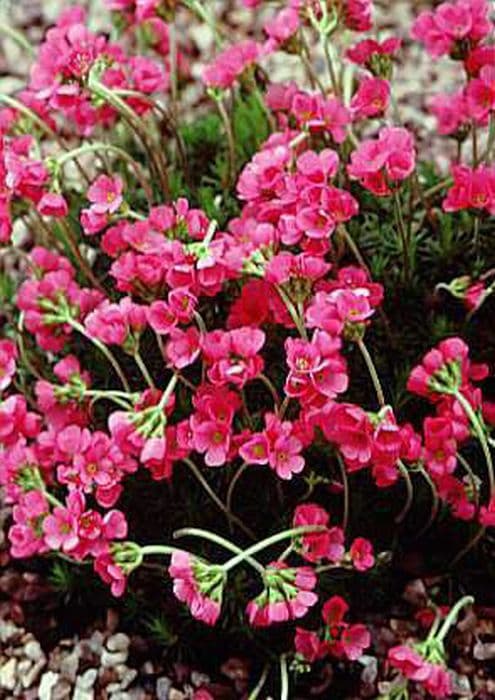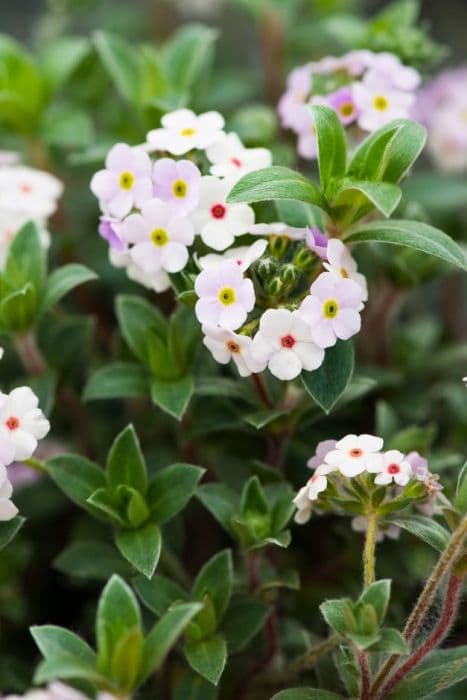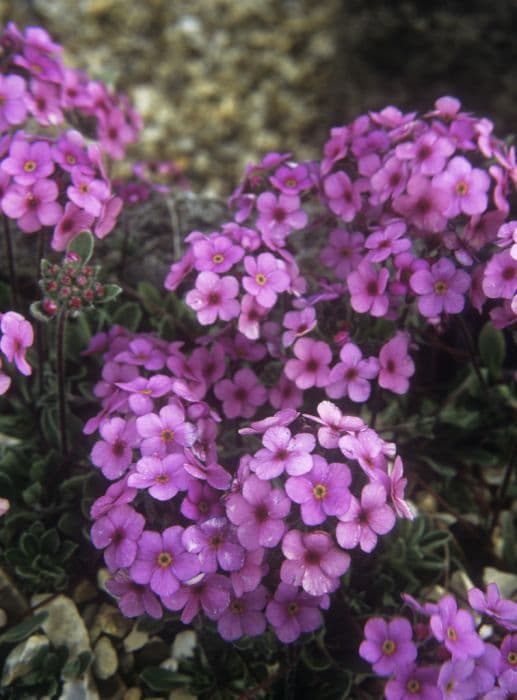Auricula 'Chiffon' Primula auricula 'Chiffon' (Au/s)

ABOUT
'Chiffon' is an evergreen, perennial, show auricula up to 20cm tall, with rosettes of pale grey-green leaves. Clusters of scented, dusky rose-pink flowers, with cream centres and yellow eyes, are produced on short stems in spring
About this plant
 Names
NamesFamily
Primulaceae
Synonyms
Bear's Ear Auricula, Mountain Cowslip, Bear's Ear Primrose
Common names
Primula auricula 'Chiffon'.
 Characteristics
CharacteristicsLife cycle
Perennials
Foliage type
Evergreen
Color of leaves
Green
Flower color
Yellow
Height
6 inches (15 cm)
Spread
6 inches (15 cm)
Plant type
Herb
Hardiness zones
4
Native area
Europe
Benefits
 General Benefits
General Benefits- Ornamental Value: Primula auricula 'Chiffon' adds aesthetic beauty to gardens with its unique and striking flowers.
- Low Maintenance: It requires minimal care beyond basic watering and occasional feeding, making it a convenient choice for busy gardeners.
- Drought Tolerance: Once established, it is relatively drought-tolerant, reducing the need for frequent watering.
- Cold Hardy: This plant can survive in cooler climates and is able to withstand frost, making it suitable for a variety of garden settings.
- Attracts Pollinators: The flowers attract bees and butterflies, which are valuable for pollination of gardens and ecosystems.
- Compact Size: Its smaller size makes it suitable for container gardening or for those with limited garden space.
 Medical Properties
Medical PropertiesThis plant is not used for medical purposes.
 Air-purifying Qualities
Air-purifying QualitiesThis plant is not specifically known for air purifying qualities.
 Other Uses
Other Uses- Auricula 'Chiffon' can be used in miniature and fairy gardens due to their small size, making them a whimsical addition to such themed areas.
- The vibrant flowers can be pressed and used in crafting, like creating bookmarks or embellishing handmade greeting cards.
- Auriculas are sometimes used in botanical illustration and watercolor painting, serving as a beautiful subject for artists.
- For photography enthusiasts, Auricula 'Chiffon' provides a photogenic subject due to its unique coloration and form.
- The petals of Auricula 'Chiffon' can be used to naturally color textiles or art projects, although it's a less common application.
- These plants are collected and displayed in traditional 'Auricula Theatres', which are special shelving units to showcase the numerous varieties during shows.
- In colder climates, Auriculas can be grown in alpine greenhouses and provide a colorful display when outdoor gardens are dormant.
- Enthusiasts might use the genetic variability of Auricula 'Chiffon' to try and selectively breed new cultivars with desired traits.
- Auricula flowers can be used as natural confetti for celebrations, providing a biodegradable and eco-friendly alternative to traditional confetti.
- They can serve as educational tools in schools or botanical gardens, illustrating concepts of plant growth, flower anatomy, and pollination.
Interesting Facts
 Feng Shui
Feng ShuiThe plant Primula is not used in Feng Shui practice.
 Zodiac Sign Compitability
Zodiac Sign CompitabilityThe plant Primula is not used in astrology practice.
 Plant Symbolism
Plant Symbolism- Unique Beauty: As a cultivar with uncommonly delicate ruffled petals and a pastel color palette, auricula 'Chiffon' symbolizes unique and understated beauty, representing a sense of sophistication and rarity.
- Courage and Creativity: Primula auricula is part of the primrose family, which is often associated with courage due to its early spring blooming. As a cultivar with such distinct characteristics, 'Chiffon' additionally represents creativity and the courage to stand out.
- Renewal and Hope: Blooming in the early spring, primroses symbolize new beginnings and the hope that comes with the end of winter, suggesting rejuvenation and the promise of future joys.
 Water
WaterPrimrose 'Chiffon' prefers consistent moisture and should be watered when the top inch of soil begins to feel dry to the touch. Watering frequency may vary but typically ranges from once a week to every other week, depending on environmental conditions such as temperature and humidity. Use room temperature water to gently soak the soil, providing approximately 16 ounces each time for a standard 6-inch pot. Avoid overwatering, as primroses are sensitive to soggy conditions which can lead to root rot.
 Light
LightThe Primrose 'Chiffon' thrives in bright, indirect light but can tolerate partial shade conditions. The best spot for the plant would be near a window that receives morning light or filtered afternoon sun. Avoid placing it in direct, harsh sunlight which can scorch its delicate leaves.
 Temperature
TemperaturePrimrose 'Chiffon' prefers cool to moderate temperatures and performs best when the temperature ranges between 50 to 70 degrees Fahrenheit. It can tolerate a minimum temperature of around 40 degrees Fahrenheit but should be protected from frost. Avoid exposing the plant to temperatures above 80 degrees Fahrenheit, as excessive heat can cause stress.
 Pruning
PruningPrimrose 'Chiffon' benefits from pruning to remove spent flowers and encourage a tidy growth habit. Deadheading, or removing faded blooms, can be done as needed throughout the blooming period to promote continued flowering. The best time for more extensive pruning is after the plant has finished blooming, at which point you can cut back any leggy or dead growth.
 Cleaning
CleaningAs needed
 Soil
SoilThe Auricula Primrose thrives in well-draining, fertile soil with good organic matter. A suitable mix could include equal parts of loam, peat, and coarse sand or perlite. It prefers a pH around 6.0 to 7.0. Ensure that the soil is loose and airy to prevent waterlogging, which can cause root rot in these plants.
 Repotting
RepottingAuricula Primroses should be repotted every one to two years to replenish the soil and give the roots room to grow. The best time to repot is after flowering, usually in the spring or early summer. If the plant becomes too crowded or the soil appears exhausted, it's time for a new container and fresh soil.
 Humidity & Misting
Humidity & MistingAuricula Primroses enjoy moderate humidity levels, not too high or too low. Aim for a humidity level between 40-60%. These plants can thrive in the average indoor humidity but can benefit from increased humidity if the air is particularly dry, like in a heated home during winter.
 Suitable locations
Suitable locationsIndoor
Place in bright, indirect light; keep soil moist but not wet.
Outdoor
Plant in partial shade; protect from intense midday sun.
Hardiness zone
4-8 USDA
 Life cycle
Life cyclePrimula auricula 'Chiffon' (Au/s), commonly known as Auricula, begins its life cycle when seeds are sown in a well-draining soil mix during late winter or early spring. The seeds germinate, typically within a few weeks, as long as they are kept moist and in a cool environment. Once germinated, the seedlings grow into small rosettes; during this vegetative stage, they develop a strong root system and foliage. After a year or a growing season, the Auricula reaches maturity and produces stalks bearing clusters of ornate, pastel flowers in spring, often in the second year after germination. Following pollination, which is aided by insects, the flowers develop into seed capsules that, once dried, release seeds for the continuation of the cycle. During the winter, the plant enters a period of dormancy, but as a perennial, it survives to re-sprout and bloom again in the subsequent growing season.
 Propogation
PropogationPropogation time
Spring-Early Summer
Primula auricula 'Chiffon', commonly known as Bear's ear auricula, is most commonly propagated by division which is usually done after flowering in late spring or early summer. To propagate by division, carefully lift the plant from the ground with a garden fork, ensuring as much of the root system is intact as possible. Gently tease apart the clumps into smaller sections, each with a portion of the root system. Once divided, replant the sections at the same depth they were growing at previously and water them well. This allows each division to establish a strong root system before the cooler winter months arrive. It's important to maintain consistent moisture without overwatering and to provide a light, fertile soil to encourage growth.









